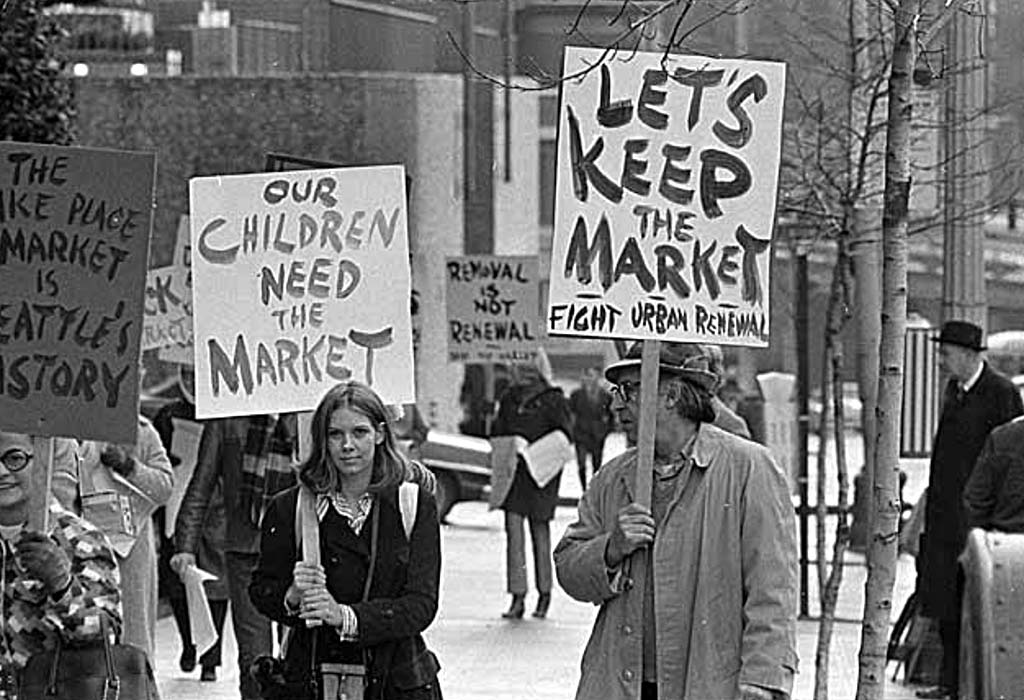-
Friends of the Market, Armory
Victor Steinbrueck Park
Steinbrueck Park totem poles
Pike Place Market went through a period of steep decline beginning with the Japanese Internment in 1942. In that year, two-thirds of the Market farmers were uprooted and sent to incarceration camps. After World War II, the rise of the supermarket, proliferation of at-home refrigerators, and movement toward the suburbs spelled doom for the Pike Place Market. To keep the cost of produce in the Market competitive, Richard Desimone operated Pike Place at a loss. Buildings were deteriorating, and in the 1960s the City unveiled a plan for urban renewal. The so-called Scheme 23 visualized a new urban landscape in which the Market would be torn down in favor of a series of towers, parking, and an indoor hockey arena. But after a protracted legal battle, the Market was saved by a citizen’s initiative in 1971, although not without some losses. One of the greatest of these losses was the National Guard Armory, which stood just north of this spot where Cutters Crabhouse stands now. It was torn down in March 1968.
In 1982, the Market Park was constructed as a lid on top of a three-story parking garage, replacing a gas station that stood here. Designed by Richard Haag and Victor Steinbrueck, the park offered picnic tables, benches, grassy knolls for admiring the view, and two totem poles made of Western Red Cedar sourced from the Skagit National Forest. The poles were designed by Quinault artist Marvin Oliver and Victor Steinbrueck, and carved with the help of James Bender and installed in 1984. The park was renamed for Steinbrueck in 1985 after his death.
In a letter dated from 1984, Steinbrueck outlined the design: “The poles are a tribute to the cultural contribution and the heritage of our Native Americans as well as having an urban design and civic amenities association with the Pioneer Square totem pole … The poles are not legendary as is often intended with such work, but may have symbolism with varied interpretations. The four main figures on the Haida pole, from bottom to top are Bear, Killer Whale or Blackfish, Human, and Raven. Only red and black paint stain colors are used in combination with the expressed natural cedar. The symbolism may be thought of as related to the City of Seattle, or to the Pike Place Public Market, or both. One interpretation of the symbolism is that Bear represents strength and power, Killer Whale or Blackfish is for good luck and abundance from the sea and nature, Human holding the Potlatch Copper is Prosperity while Raven at the top brings light and Hope to Seattle and the Market and all of us. There are several small figures intertwined with the main elements. Bear is holding a Hawk which may signify Vigilance and Watchfulness perhaps in relation to our own Powers. Next at the top of Bear is Little raven possibly representing Luminous Energy in relation to Bear’s Strength and for the good luck an abundance of the Killer Whale. Killer Whale as a figurative Blow Hole face or mask and Messenger is a Little Human with Feathers between the whale tail fins which suggests communication within our communities, or between people and Nature; the Salish Women’s Spinning Whorl held by Raven may symbolize the contribution of Native Americans through the combination of work and art, especially recognizing the work of women in our society.
“The Market Farmers Pole with its twin eight-foot-high figures is related to the Pike Place Public Market as a monument and acknowledgement of gratitude to the farm women and men who toil to bring the agricultural riches of our region to the people of Seattle. The farmer woman and the farmer man, as the most important element of the Market, are wearing “Honored Farmers – 1984″ badges similar to those presented by the Friends of the Market to the old-time farmers in 1984 who had been in the Market for many years.”
Walk east through the park, and across Western Avenue. The next stop is at the southwest corner of Pike Place & Virginia Street, near the concrete slabs from 1929 and the pergola that was added after the 1977 rehabilitation.





